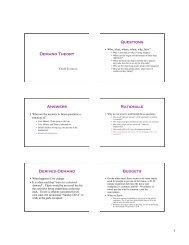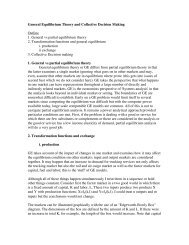multi-modal trip distribution: structure and application
multi-modal trip distribution: structure and application
multi-modal trip distribution: structure and application
You also want an ePaper? Increase the reach of your titles
YUMPU automatically turns print PDFs into web optimized ePapers that Google loves.
Levinson <strong>and</strong> Kumar<br />
________________________________________________________________________<br />
Each household was assigned a specific 24 hour "travel day" <strong>and</strong> information was collected on<br />
all <strong>trip</strong>s made by members of that household on that day. A <strong>trip</strong> was defined as one-way travel<br />
from one address to another. The location of both ends of the <strong>trip</strong> was reported along with the<br />
time of departure <strong>and</strong> arrival. Trip duration was obtained by subtracting time of departure from<br />
that of arrival. This data also report <strong>trip</strong> purpose at both origin <strong>and</strong> destination ends, making it<br />
possible to identify work <strong>trip</strong>s by accounting for <strong>trip</strong> chaining (which is defined as travel to a<br />
non-work location on the way between home <strong>and</strong> work).<br />
Three primary travel modes are defined in the two surveys, transit, automobile, <strong>and</strong> walk.<br />
Travel by automobile is further divided by number of person per vehicle, where AUTO-1 is a<br />
driver with no passengers, AUTO-2 is a <strong>trip</strong> in a car with a driver <strong>and</strong> one passenger, <strong>and</strong><br />
AUTO-3 is a <strong>trip</strong> in a car with a driver <strong>and</strong> two or more passengers. Transit includes both rail<br />
(Metrorail <strong>and</strong> Commuter Rail) <strong>and</strong> bus. The 1988 survey also provides information on the mode<br />
of access to Metrorail, which includes walk to rail or walk to bus to rail (WCT), auto driver or<br />
"park <strong>and</strong> ride" (ADT), <strong>and</strong> auto passenger or "kiss <strong>and</strong> ride" (APT).<br />
Seven <strong>trip</strong> purposes are defined in this <strong>application</strong>: Home to Work (H2W), Work to<br />
Home (W2H), Home to Other (H2O), Other to Home (O2H), Other to Work (O2W), Work to<br />
Other (W2O), <strong>and</strong> Other to Other (O2O). For estimation, these were grouped into three<br />
categories, Work, Non-work, <strong>and</strong> Chained Work. Because chained work <strong>trip</strong>s (W20) was<br />
observed to have a very similar <strong>distribution</strong> to work to home (W2H), these purposes were<br />
consolidated for the estimation of <strong>trip</strong> impedance. The approach adopted here is different from<br />
that undertaken in earlier studies which only differentiate between "Home-Based" <strong>and</strong> "Non-<br />
Home Based" <strong>trip</strong>s. By segmenting <strong>trip</strong>s by direction, a better underst<strong>and</strong>ing of asymmetric<br />
travel patterns, such as linked <strong>trip</strong>s, is possible.<br />
Estimation<br />
Many conventional <strong>trip</strong> <strong>distribution</strong> models are stratified by income or auto ownership,<br />
which serves as a surrogate for income. While in concept, stratification for income (or any<br />
number of other demographic variables) is desirable, this model was not stratified as income is<br />
________________________________________________________________________<br />
December 17, 1996 6







